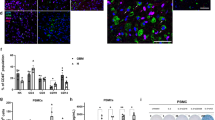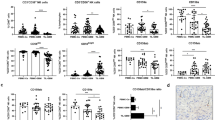Abstract
Glioblastoma (GBM) is a highly aggressive brain tumor for which novel therapeutic approaches, such as immunotherapy, are urgently needed. Zoledronate (ZOL), an inhibitor of osteoclastic activity, is known to stimulate peripheral blood-derived γδT cells and sensitize tumors to γδT cell-mediated killing. To investigate the feasibility of γδT cell-based immunotherapy for patients with GBM, we focused on the killing of GBM cell lines by γδT cells and the molecular mechanisms involved in these cell–cell interactions. Peripheral blood mononuclear cells were expanded in ZOL and interleukin (IL)-2 for 14 days, and γδT cells were enriched in the expanded cells by the immunomagnetic depletion of αβT cells. Gliomas are resistant to NK cells but susceptible to lymphokine-activated killer cells and some cytotoxic T lymphocytes. When the γδT cell-mediated killing of three GBM cell lines (U87MG, U138MG and A172 cells) and an NK-sensitive leukemia cell line (K562 cells) were tested, 32 % U87MG, 15 % U138MG, 1 % A172, and 50 % K562 cells were killed at an effector:target ratio of 5:1. The γδT cell-mediated killing of all three GBM cell lines was significantly enhanced by ZOL and this ZOL-enhanced killing was blocked by an anti-T cell receptor (TcR) antibody. These results indicated that TcR γδ is crucial for the recognition of ZOL-treated GBM cells by γδT cells. Since the low level killing of GBM cells by the γδT cells was enhanced by ZOL, γδT cell-targeting therapy in combination with ZOL treatment could be effective for patients with GBM.




Similar content being viewed by others
References
Stupp R, Mason WP, van den Bent MJ, Weller M, Fisher B, Taphoorn MJ, Belanger K, Brandes AA, Marosi C, Bogdahn U, Curschmann J, Janzer RC, Ludwin SK, Gorlia T, Allgeier A, Lacombe D, Cairncross JG, Eisenhauer E, Mirimanoff RO (2005) Radiotherapy plus concomitant and adjuvant temozolomide for glioblastoma. N Engl J Med 352:987–996
Stupp R, Hegi ME, Mason WP, van den Bent MJ, Taphoorn MJ, Janzer RC, Ludwin SK, Allgeier A, Fisher B, Belanger K, Hau P, Brandes AA, Gijtenbeek J, Marosi C, Vecht CJ, Mokhtari K, Wesseling P, Villa S, Eisenhauer E, Gorlia T, Weller M, Lacombe D, Cairncross JG, Mirimanoff RO (2009) Effects of radiotherapy with concomitant and adjuvant temozolomide versus radiotherapy alone on survival in glioblastoma in a randomised phase III study: 5-year analysis of the EORTC-NCIC trial. Lancet Oncol 10:459–466
Yamanaka R (2006) Novel immunotherapeutic approaches to glioma. Curr Opin Mol Ther 8:46–51
Vauleon E, Avril T, Collet B, Mosser J, Quillien V (2010) Overview of cellular immunotherapy for patients with glioblastoma. Clin Dev Immunol. doi:10.1155/2010/689171
Ogbomo H, Cinatl J Jr, Mody CH, Forsyth PA (2011) Immunotherapy in gliomas: limitations and potential of natural killer (NK) cell therapy. Trends Mol Med 17:433–441
Hayday AC (2000) γδ cells: a right time and a right place for a conserved third way of protection. Annu Rev Immunol 18:975–1026
Bonneville M, O’Brien RL, Born WK (2010) γδT cell effector functions a blend of innate programming and acquired plasticity. Nat Rev Immunol 10:467–478
Haas W, Pereira P, Tonegawa S (1993) Gamma/delta cells. Annu Rev Immunol 11:637–685
Kabelitz D, Wesch D, He W (2007) Perspectives of γδT cells in tumor immunology. Cancer Res 67:5–8
Gober HJ, Kistowska M, Angman L, Jeno P, Mori L, De Libero G (2003) Human T cell receptor γδ cells recognize endogenous mevalonate metabolites in tumor cells. J Exp Med 197:163–168
Hintz M, Reichenberg A, Altincicek B, Bahr U, Gschwind RM, Kollas AK, Beck E, Wiesner J, Eberl M, Jomaa H (2001) Identification of (E)-4-hydroxy-3-methyl-but-2-enyl pyrophosphate as a major activator for human γδT cells in Escherichia coli. FEBS Lett 509:317–322
Vantourout P, Mookerjee-Basu J, Rolland C, Pont F, Martin H, Davrinche C, Martinez LO, Perret B, Collet X, Perigaud C, Peyrottes S, Champagne E (2009) Specific requirements for Vγ9 Vδ2 T cell stimulation by a natural adenylated phosphoantigen. J Immunol 183:3848–3857
Harly C, Guillaume Y, Nedellec S, Peigne CM, Monkkonen H, Monkkonen J, Li J, Kuball J, Adams EJ, Netzer S, Dechanet-Merville J, Leger A, Herrmann T, Breathnach R, Olive D, Bonneville M, Scotet E (2012) Key implication of CD277/Butyrophilin-3 (BTN3A) in cellular stress sensing by a major human γδT cell subset. Blood 120:2269–2279
Toutirais O, Cabillic F, Le Friec G, Salot S, Loyer P, Le Gallo M, Desille M, de La Pintiere CT, Daniel P, Bouet F, Catros V (2009) DNAX accessory molecule-1 (CD226) promotes human hepatocellular carcinoma cell lysis by Vγ9 Vδ2 T cells. Eur J Immunol 39:1361–1368
Dieli F, Vermijlen D, Fulfaro F, Caccamo N, Meraviglia S, Cicero G, Roberts A, Buccheri S, D’Asaro M, Gebbia N, Salerno A, Eberl M, Hayday AC (2007) Targeting human γδT cells with zoledronate and interleukin-2 for immunotherapy of hormone-refractory prostate cancer. Cancer Res 67:7450–7457
Corvaisier M, Moreau-Aubry A, Diez E, Bennouna J, Mosnier JF, Scotet E, Bonneville M, Jotereau F (2005) Vγ9 Vδ2 T cell response to colon carcinoma cells. J Immunol 175:5481–5488
Meraviglia S, Eberl M, Vermijlen D, Todaro M, Buccheri S, Cicero G, La Mendola C, Guggino G, D’Asaro M, Orlando V, Scarpa F, Roberts A, Caccamo N, Stassi G, Dieli F, Hayday AC (2010) In vivo manipulation of Vγ9 Vδ2 T cells with zoledronate and low-dose interleukin-2 for immunotherapy of advanced breast cancer patients. Clin Exp Immunol 161:290–297
Gomes AQ, Martins DS, Silva-Santos B (2010) Targeting γδT lymphocytes for cancer immunotherapy: from novel mechanistic insight to clinical application. Cancer Res 70:10024–10027
Todaro M, D’Asaro M, Caccamo N, Iovino F, Francipane MG, Meraviglia S, Orlando V, La Mendola C, Gulotta G, Salerno A, Dieli F, Stassi G (2009) Efficient killing of human colon cancer stem cells by γδT lymphocytes. J Immunol 182:7287–7296
Fujimiya Y, Suzuki Y, Katakura R, Miyagi T, Yamaguchi T, Yoshimoto T, Ebina T (1997) In vitro interleukin 12 activation of peripheral blood CD3(+)CD56(+) and CD3(+)CD56(-) gammadelta T cells from glioblastoma patients. Clin Cancer Res 3:633–643
Bryant NL, Suarez-Cuervo C, Gillespie GY, Markert JM, Nabors LB, Meleth S, Lopez RD, Lamb LS Jr (2009) Characterization and immunotherapeutic potential of γδT-cells in patients with glioblastoma. Neuro Oncol 11:357–367
Bryant NL, Gillespie GY, Lopez RD, Markert JM, Cloud GA, Langford CP, Arnouk H, Su Y, Haines HL, Suarez-Cuervo C, Lamb LS Jr (2011) Preclinical evaluation of ex vivo expanded/activated γδT cells for immunotherapy of glioblastoma multiforme. J Neurooncol 101:179–188
Sato K, Kimura S, Segawa H, Yokota A, Matsumoto S, Kuroda J, Nogawa M, Yuasa T, Kiyono Y, Wada H, Maekawa T (2005) Cytotoxic effects of γδT cells expanded ex vivo by a third generation bisphosphonate for cancer immunotherapy. Int J Cancer 116:94–99
Kobayashi H, Tanaka Y, Yagi J, Minato N, Tanabe K (2011) Phase I/II study of adoptive transfer of γδT cells in combination with zoledronic acid and IL-2 to patients with advanced renal cell carcinoma. Cancer Immunol Immunother 60:1075–1084
Abe Y, Muto M, Nieda M, Nakagawa Y, Nicol A, Kaneko T, Goto S, Yokokawa K, Suzuki K (2009) Clinical and immunological evaluation of zoledronate-activated Vγ9γδT-cell-based immunotherapy for patients with multiple myeloma. Exp Hematol 37:956–968
Nakajima J, Murakawa T, Fukami T, Goto S, Kaneko T, Yoshida Y, Takamoto S, Kakimi K (2010) A phase I study of adoptive immunotherapy for recurrent non-small-cell lung cancer patients with autologous γδT cells. Eur J Cardiothorac Surg 37:1191–1197
Lichtenfels R, Biddison WE, Schulz H, Vogt AB, Martin R (1994) CARE-LASS (calcein-release-assay), an improved fluorescence-based test system to measure cytotoxic T lymphocyte activity. J Immunol Meth 172:227–239
Cimini E, Piacentini P, Sacchi A, Gioia C, Leone S, Lauro GM, Martini F, Agrati C (2011) Zoledronic acid enhances Vδ2 T-lymphocyte antitumor response to human glioma cell lines. Int J Immunopathol Pharmacol 24:139–148
Kuroda J, Kimura S, Segawa H, Kobayashi Y, Yoshikawa T, Urasaki Y, Ueda T, Enjo F, Tokuda H, Ottmann OG, Maekawa T (2003) The third-generation bisphosphonate zoledronate synergistically augments the anti-Ph + leukemia activity of imatinib mesylate. Blood 102:2229
Battistini L, Salvetti M, Ristori G, Falcone M, Raine CS, Brosnan CF (1995) γδT cell receptor analysis supports a role for HSP 70 selection of lymphocytes in multiple sclerosis lesions. Mol Med 1:554–562
Nathanson D, Mischel PS (2011) Charting the course across the blood–brain barrier. J Clin Invest 121:31–33
Coomber BL, Stewart PA, Hayakawa K, Farrell CL, Del Maestro RF (1987) Quantitative morphology of human glioblastoma multiforme microvessels: structural basis of blood–brain barrier defect. J Neurooncol 5:299–307
Acknowledgments
This work was supported by a Grant-in-Aid for Scientific Research from the Ministry of Education, Culture, Sports, Science, and Technology of Japan (No. 22791352).
Conflict of interest
The authors declare that they have no conflict of interest.
Ethical standards
The study design was approved by the ethics committee at Clinic Grandsoul Nara, Uda, Japan, and conformed to the Declaration of Helsinki.
Author information
Authors and Affiliations
Corresponding author
Electronic supplementary material
Below is the link to the electronic supplementary material.
Rights and permissions
About this article
Cite this article
Nakazawa, T., Nakamura, M., Park, Y.S. et al. Cytotoxic human peripheral blood-derived γδT cells kill glioblastoma cell lines: implications for cell-based immunotherapy for patients with glioblastoma. J Neurooncol 116, 31–39 (2014). https://doi.org/10.1007/s11060-013-1258-4
Received:
Accepted:
Published:
Issue Date:
DOI: https://doi.org/10.1007/s11060-013-1258-4




